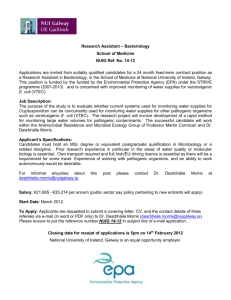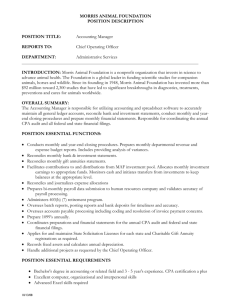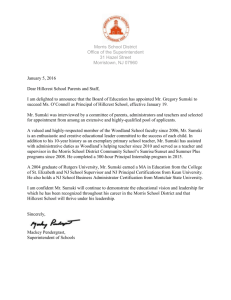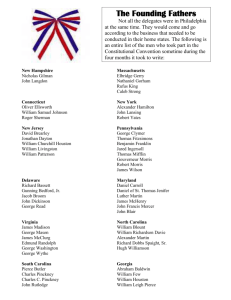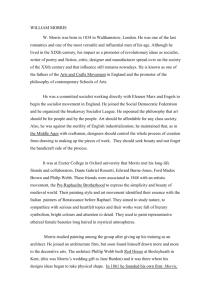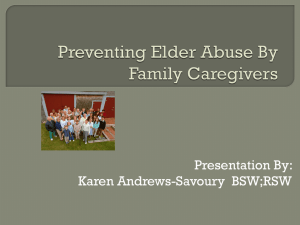Topic Notes 3 Running a successful design
advertisement
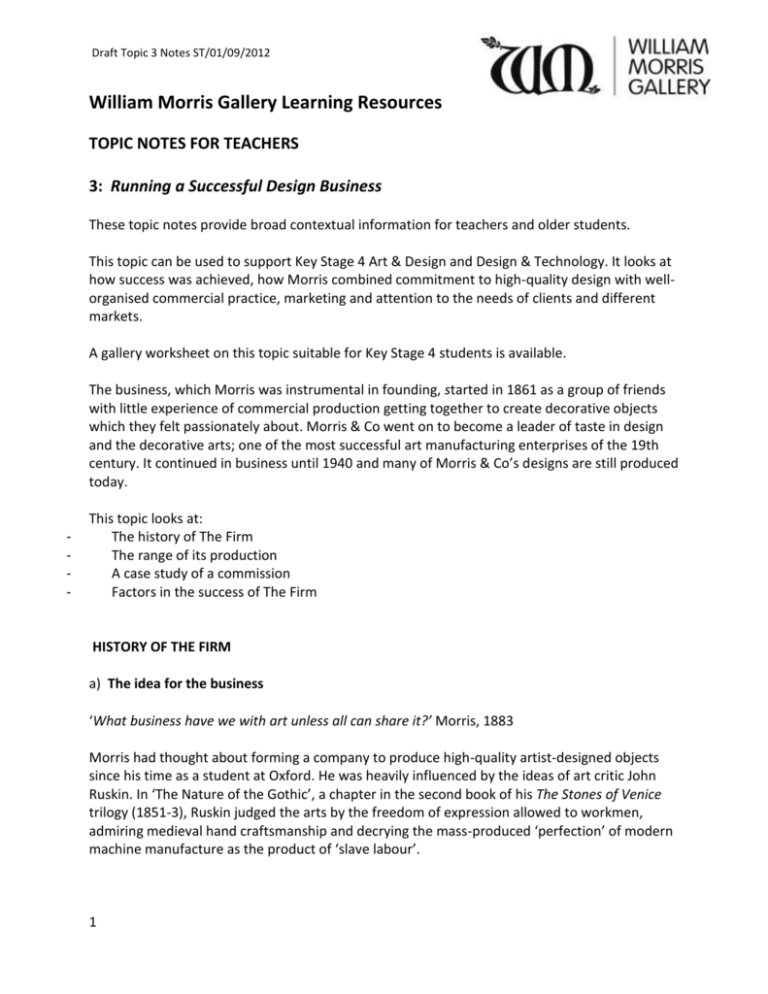
Draft Topic 3 Notes ST/01/09/2012 William Morris Gallery Learning Resources TOPIC NOTES FOR TEACHERS 3: Running a Successful Design Business These topic notes provide broad contextual information for teachers and older students. This topic can be used to support Key Stage 4 Art & Design and Design & Technology. It looks at how success was achieved, how Morris combined commitment to high-quality design with wellorganised commercial practice, marketing and attention to the needs of clients and different markets. A gallery worksheet on this topic suitable for Key Stage 4 students is available. The business, which Morris was instrumental in founding, started in 1861 as a group of friends with little experience of commercial production getting together to create decorative objects which they felt passionately about. Morris & Co went on to become a leader of taste in design and the decorative arts; one of the most successful art manufacturing enterprises of the 19th century. It continued in business until 1940 and many of Morris & Co’s designs are still produced today. - This topic looks at: The history of The Firm The range of its production A case study of a commission Factors in the success of The Firm HISTORY OF THE FIRM a) The idea for the business ‘What business have we with art unless all can share it?’ Morris, 1883 Morris had thought about forming a company to produce high-quality artist-designed objects since his time as a student at Oxford. He was heavily influenced by the ideas of art critic John Ruskin. In ‘The Nature of the Gothic’, a chapter in the second book of his The Stones of Venice trilogy (1851-3), Ruskin judged the arts by the freedom of expression allowed to workmen, admiring medieval hand craftsmanship and decrying the mass-produced ‘perfection’ of modern machine manufacture as the product of ‘slave labour’. 1 Draft Topic 3 Notes ST/01/09/2012 Morris and his friends had had the experience of designing medieval style furniture for his lodgings in Red Lion Square (1856-9) – shared with the artist Edward Burne-Jones – and then, in 1859-60, the complete design and furnishing of his new marital home Red House in Bexleyheath. This was designed and built by Morris’s architect friend Philip Webb. Morris was searching for a meaningful career in the Arts, having given up architecture after eight months of working for the Gothic Revival architect, George Street. Although he did have private income from his family he still needed to find a profession. He had also tried to become a painter tutored by his friend Pre-Raphaelite artist Dante Gabriel Rossetti, but Morris lacked confidence in his ability to draw figures; an essential for the ‘serious’ history painter. Instead he decided to put his eye for design and energy for organisation into making high-quality decorative arts widely available. b) Foundation of Morris, Marshall, Faulkner & Co, 1861 ‘The growth of decorative art in this country … has now reached a point at which it seems desirable that artists of reputation should devote their time to it.’ Morris, Marshall, Faulkner & Co prospectus, 1861 The Firm was formally established in April 1861 with seven partners. Morris’s mother lent them £100 working capital. Each partner had a £20 share and Morris was made business manager at a salary of £150 per year. These were a close-knit group of friends with common interests and a good range of complementary skills and experience. The other six partners were: - - - 2 Dante Gabriel Rossetti: a founding member of the Pre-Raphaelite Brotherhood and famous as a painter and a poet. Both Morris and Burne-Jones had studied informally in Rossetti’s studio to kick-start their careers as artists. His host of society and art-world contacts were crucial to The Firm’s early success. Ford Madox Brown: Also a well-established painter closely associated with the PreRaphaelites. Madox Brown was friend and one-time tutor of Rossetti. He shared Morris’s strong sense of social justice. Madox Brown designed stained glass, furniture and tiles for The Firm. Edward Burne-Jones: Morris’s closest friend whom he first met at Pembroke College Oxford. Burne-Jones enjoyed early success in an independent career as a painter. He became The Firm’s chief designer of tapestry and designed stained glass. His ability to draw people complemented Morris’s talent for repeat patterns and decorative detail. Philip Webb: Morris’s former colleague at architect George Street’s practice who later established his own architectural practice. Webb designed furniture, interiors and glass for The Firm. Charles Faulkner: Another friend from Oxford. He was a mathematics don and trained as an engineer. Initially he kept the accounts. He was also an amateur painter and he contributed to tile painting for The Firm. Peter Paul Marshall: A surveyor and sanitary engineer by profession; also a friend and pupil of Madox Brown and a talented amateur painter. He was not a very active partner. Draft Topic 3 Notes ST/01/09/2012 Initial success followed by a ‘slump’ The Firm had initial success largely due to high demand for stained-glass windows as part of a boom in church building in the mid-19th century. However, an economic recession in the late 1860s led to a severe drop in profits. Things began to improve in the 1870s as Morris worked hard to develop a more diverse range of products appealing to a wider customer base, i.e. handprinted textiles, comprehensive interior design schemes for rich clients and cheaper ranges for the less well off, for example embroidery kits or the simple Sussex rush-seated chair based on a traditional country design. Morris & Co from 1874 Having done the major part of the work of bringing The Firm back to profit, Morris bought out the other partners with an agreed payment of £1000 each. This followed much acrimonious wrangling causing Rossetti and Madox Brown to fall out with Morris for good. Webb, BurneJones and Faulkner remained close friends and continued to work for The Firm. They were paid fees for each piece of work undertaken but no longer as partners. Under Morris’s sole direction The Firm continued to expand, opening an Oxford Street shop/showroom in 1877 and for a while a shop in Manchester, with agents in Europe, Australia, Canada and America. In 1881 Morris moved production from the workshops in Red Lion Square to much larger premises – former silk-weaving sheds at Merton Abbey, south-west London. This enabled The Firm to expand into tapestry, carpet weaving and natural dyeing of yarns. By 1890, Morris became increasingly busy with political campaigning and writing, he made two of his managers – Frank and Robert Smith – partners so he would be freed from day to day operations. Morris & Co after Morris After Morris’s death in 1896, The Firm continued to trade with some success. John Henry Dearle, Morris’s trusted assistant, became art director. Morris and Burne-Jones’ designs continued to be re-used, but without the artistic leadership to innovate and adapt to changing tastes the business foundered and closed for good in 1940. However, the printed fabrics and wallpapers have been printed almost continuously since Morris’s death. Colours and techniques have been adapted to suit modern taste but the demand for the patterns has never disappeared. RANGE OF THE FIRM’S ACTIVITIES The main activities of The Firm were interior design, furniture, wallpapers and textiles, including printed fabric, tapestry, embroidery and carpets. In the early years, tile painting for wall and 3 Draft Topic 3 Notes ST/01/09/2012 fireplace decoration was done in-house but after the 1870s they came from William De Morgan’s firm. For more details of this production, see Techniques & Materials topics. Interior Design Case Study: The Green Dining Room at the V&A Interior design was at the heart of the business and The Firm were lucky to get two very high profile public commissions early on. These were the Armoury and Tapestry Room of St James’s Palace and the Green Dining Room at the Victoria and Albert Museum which is still in use today. The client The South Kensington Museum, as it was then known, had been established in 1852 after the Great Exhibition with the remit to promote good design. MMF & Co were known to the museum from the success of their ‘medieval’ stand at the 1862 International Exhibition. Morris was a frequent user of the museum to research his designs. The museum’s architect, Francis Fowke, also had links with Philip Webb. The brief Fowke asked The Firm to design and build a public dining room to complete a trio of large refreshment rooms on the ground floor. The client’s aims were that the design and building of the museum and the decorative details should be inspiring and instructive in themselves. This room needed to complement and contrast with the other two existing dining rooms – the large central Gamble Room with an elaborate Renaissance style interior, and the East Grill Room designed by Edward Poynter in the simpler style of a Dutch kitchen, using large pictorial tiles to decorate the walls. The design The overall design was by Philip Webb. He presented a detailed proposal drawing to the client in October 1866. The scheme shows a complex layering of pattern upon pattern, but carefully balanced through colour and proportion. This was to become a trademark of The Firm. The wall surface was divided into five distinct areas: - A dado of oak panels stained with deep green - A row of painted panelling by Burne-Jones, featuring the months of the Zodiac interspersed with vegetation - Wall filling – a layer of moulded plaster panels with olive branch motif in relief - A ceiling frieze featuring scenes of dogs chased by hares, designed by Webb and based on a font in Newcastle Cathedral - Stained-glass window designed by Burne-Jones The work Careful plans and estimates were made. The estimates for the individual elements were very costly, for example £272 for the stained glass: £291 was paid to Burne-Jones for 70 painted panels. The work was very complex and slow; the time estimate for painting the dado was that one man would take 243 days at a cost of £18.16s for the labour. The actual decorating and building was subcontracted out. 4 Draft Topic 3 Notes ST/01/09/2012 Success Of all the three rooms, the style of the Green Dining Room had the most impact. It became the meeting place for ‘men of taste’ in London, admired by artists such as Whistler, George du Maurier and Poynter. The complex organisation of the project provided a model for The Firm to work on other schemes. Discussion Look at images of the rooms on the V&A website. What do students think of the scheme? Compare it with the other two rooms. How does it fit with contemporary taste? Did it fulfil the brief to be distinctive? Students can create their own interior design proposal for a contemporary client (see Worksheet.) How would they present their ideas, cost out and plan a timescale for the work? FACTORS IN THE SUCCESS OF THE FIRM Effective use of staff: talent spotting Morris proved good at talent spotting, matching the right person to the job, and was not above ‘poaching’ from rival firms. For example, as foreman of the glass painters, Morris recruited George Campfield who had been employed by one of the most respected firms of stained-glass manufacturers, Heaton, Butler & Bayne. Friends and family Morris made the most of those around him. Morris & Co offered rare opportunities for employment for middle-class Victorian women. His wife Jane took charge of embroidery, aided by her sister Bessie Burden. Later Morris’s daughter May became head of The Firm’s Embroidery Department aged 23. Charles Faulkner’s sisters Lucy and Kate did much of the ceramic tile painting helped by Burne-Jones’ wife Georgiana. Delegation Although very hands-on in approach, Morris was also able to delegate. Throughout his career he appointed managers ‘who combined enthusiasm, shrewdness and integrity, and allowed them considerable freedom of action’. For example, Warrington Taylor was employed in the mid 1860s as business manager to help run The Firm more efficiently. He was the first to see the commercial potential of the simple Sussex rush-seated chair which became a best seller. George Wardle was general manager 1870-90 and took over control of Merton Abbey operations and contributed much to the improvement of the printing process. JH Dearle supervised tapestry weaving and fabric departments. Morris had soon recognised his drawing skills and indeed his designs were frequently mistaken for those of Morris. He became artistic director of The Firm after Morris’s death 5 Draft Topic 3 Notes ST/01/09/2012 Collaborators If Morris could find producers that met his high standard of quality for material and production methods he would happily ‘farm out’ Morris design work rather then devote capital outlay and in-house resources to it. For example the ceramicist William De Morgan was closely associated with Morris but never part of The Firm. He had his own tile works and pottery – and had greater expertise in developing colours and glazes than those produced in the Morris kiln at Red Lion Square. De Morgan supplied Morris & Co with tiles of his designs, produced Morris’s own designs in his factory and sold Morris-designed tiles through his own company. Morris and De Morgan’s styles are at times hard to distinguish. Organisation and finance There is a perception that Morris & Co was rather chaotic and didn’t make money, perhaps due to Rossetti’s later statement that they were all ‘merely playing at business’. This was not the case. From the slump in the mid 1860s, Morris’s private income from inherited shares had lost its value so he was dependent on The Firm to support his family. From the mid-1870s onwards The Firm was very profitable and successful. From the outset MMF & Co held weekly partnership meetings at which Rossetti was the least frequent attendee! Commissions were discussed and work allocated with careful records kept. Designers were paid according to their skill and reputation, for example, Rossetti and BurneJones would get higher fees for stained-glass window design than Morris. A tile painted by Lucy Faulkner would cost far less than one by Morris or Burne-Jones. Finances were managed in a prudent professional manner, with attention to costs, prices and profit margins. Although employees’ wages were higher than average, care was taken to keep prices competitive. Morris & Co never sold at discount and required prompt payment – unusual at a time when the rich were accustomed to having prolonged credit. As Morris’s reputation soared, by the 1880s he rationed his time by charging clients for visits, although not the ‘wellknown and useful ones’. Marketing From the beginning Morris was very aware of the value of marketing and used some of the latest techniques developed by the new department stores to promote The Firm’s values: Unique selling point: Artist-led design, handcraftsmanship and quality materials. The Firm’s prospectus/brochure developed these values – beautiful designs and good quality production represented value for money. 6 Draft Topic 3 Notes ST/01/09/2012 Marketing material: It was one of the first design firms to use illustrated catalogues with prices Spotting market opportunities: For example, stained-glass production for churches became the obvious starting point for business growth due to the Church of England’s building boom and The Firm’s links with Gothic Revival architects. When this demand slumped it was Morris who led the diversification into printed paper and textiles to create a whole interior design style. Mail-outs: Morris wrote to a church contact for a copy of the clergy directory and sent out letters and prospectuses to every clergyman on the list. He persistently pursued friends and acquaintances for new contacts to whom he would write to promote The Firm. Celebrity plugs: The Firm maximised the value of the fame of their artist designers to emphasise quality and uniqueness. Although initially designs had been anonymous within the group, Morris soon realised the pulling power of exclusivity, for example in 1882 the prospectus said: ‘Mr Burne-Jones entrusts us alone with the execution of his stained glass.’ Morris himself was by then also a big draw due to his fame as a writer. Showcasing his products: Morris and The Firm made good use of the various design exhibitions of the time. For example, the MMF & Co stand at the International Exhibition of 1862 featuring examples of ‘Medieval Style’ furniture brought a lot of interest to the new company. Morris opened a showroom in Oxford Street where goods were displayed in a tasteful fashionable setting, in a location which would attract wealthy tourists from all over the world. The names, dimensions and prices were marked on all goods for ease of selection – this was not common practice in high-class shops at the time. Morris workshops as a ‘ visitor experience’ When the Merton Abbey workshops opened, this was a further opportunity to showcase not only the products but the principles on which production was founded. Visitors came to do a tour of the workshops to see the handmade techniques in action and some wrote articles and journals further spreading Morris’s fame. Diversity of products to suit a range of pockets Morris was troubled by the fact that the handcrafted items were made from quality materials which he advocated were too expensive for many people to purchase. He did ensure that some cheaper products were available, trying as far as possible to maintain a tight quality control. For example the hand-knotted ‘Hammersmith’ carpets were very costly at £113 for 16 x 13 feet, but by the late 1870s Morris’s designs were available from other cheaper manufacturers, for example, Wilton, Axminster, Brussels and Kidderminster. These were machine produced by other suppliers but quality controlled by Morris. Customers on modest incomes bought wallpapers, fabrics and carpets for inclusion in their own schemes. A few lines of machine-printed wallpaper were produced for ‘lower range’ clients. 7 Draft Topic 3 Notes ST/01/09/2012 Cheaper small items included cushion covers, work bags, fire screens. Embroidery was also popular. Kits based on The Firm’s designs with ready-dyed yarn were available at low cost. Discussion Who buys Morris designs now? What sort of house? Setting? Fashion for ‘authenticity’, for example, Victorian style in Victorian architecture; use of ‘statement’ wallpaper etc. Are Morris’s features used in a more limited way? Does Morris have ‘twee’ tea-room image? Discuss Morris as a pioneer of marketing. Look at the techniques he used. What marketing techniques are still used today? What do we have today that he didn’t? Compare with contemporary design shops and brands, for example, Ikea, Liberty Running a design business Brainstorm what makes a good design business. Look at Morris’s ‘Success Factors’. Compare with contemporary design businesses that offer a complete look. Look at the Running a Design Business interactive in Gallery 3.This can also be used online. Students can try to see if they can make a profit taking into account the different costs and demand factors involved in making a product GCSE/6th form Product Design Project Students can form small groups of six to eight people as in MMF & Co to produce their own design product according to school facilities, for example: T-shirt print, bag, ceramic container. They will need to allocate roles, for example: design, production, market research and marketing, cost control and management. They will need to think of name and brand identity for their firm. They can be allocated or contribute a small budget and look to sell products at school fairs, etc. 8
